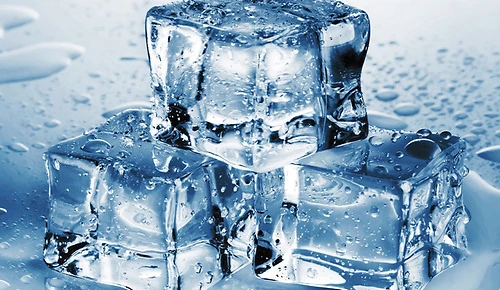
Description of the image: When an ice cube is placed on a marble slab and another on a wooden board, the ice cube on the marble melts 10 times faster than the one on the wood.
At room temperature, a marble slab feels colder to the touch than a wooden board.
If you place an ice cube on a marble slab and another on a wooden board, the ice cube on the marble melts 10 times faster than the one on the wood.
Behind the apparent paradox of this physical phenomenon lies a rational explanation.
The sensation of coldness to the touch is due to the different thermal properties of marble and wood. This is partly explained by the high thermal conductivity of marble, which means it can quickly absorb heat from your hand, giving a sensation of cold.
In contrast, wood has a lower thermal conductivity, meaning it absorbs heat from your hand more slowly. As a result, it feels less cold to the touch.
Marble, with its high thermal conductivity, allows heat to transfer quickly from the marble to the ice cube. Thus, the ice cube on the marble melts faster because it receives a greater amount of heat from the underlying material.
Conversely, the wooden board, with its lower thermal conductivity, transfers heat to the ice cube more slowly, delaying its melting.
In summary, although marble feels colder to the touch due to its high thermal conductivity, it also allows faster heat transfer, causing the ice cube placed on it to melt faster compared to the wooden board.
The equation that describes the heat transfer through a material is the heat diffusion equation. This equation is a form of Fourier's law for thermal conduction. The heat equation is generally expressed as follows in one dimension (for one-dimensional heat transfer):
\[ \frac{\partial T}{\partial t} = \alpha \frac{\partial^2 T}{\partial x^2} \]
• T is the temperature of the material,
• t is the time,
• x is the spatial position,
• α is the thermal diffusivity of the material.
This equation describes how the temperature T varies over time t and space x due to the heat flux through the material. The thermal conductivity of the material is incorporated into the coefficient α.
The values of thermal conductivity can vary slightly depending on factors such as the type of wood or marble, as well as temperature and humidity.
The thermal conductivity of wood ranges between 0.1 and 0.2 W/(m·K) for dry wood.
The thermal conductivity of marble also varies depending on its specific composition, but generally ranges between 2 and 5 W/(m·K).
The unit of thermal conductivity is expressed in watts per meter per kelvin (W/(m·K)).
The thermal conductivity of aluminum is relatively high compared to many other materials. Its typical value ranges around 200 to 230 W/(m·K). This high thermal conductivity is one of the reasons aluminum is commonly used in applications requiring efficient heat transfer, such as radiators, heat sinks for electronic components, or cookware.
However, the highest thermal conductivity is that of diamond. It can reach values of the order of 2000 to 2200 W/(m·K).
Why does aluminum or diamond not feel cold to the touch?
The sensation of coldness to the touch depends not only on the thermal conductivity of the material but also on its heat capacity.
A low specific heat capacity means that for the same amount of heat absorbed, the temperature of the material increases more rapidly compared to a material with a high specific heat capacity. In other words, a material with low heat capacity requires only a small amount of heat to undergo a significant temperature increase.
Diamond has a cubic face-centered crystal structure, where each carbon atom is bonded to four other carbon atoms with very strong covalent bonds. This regular and highly symmetrical structure allows for very efficient heat transfer.
The strong covalent bonds and the absence of impurities allow for rapid propagation of atomic vibrations (phonons) through the crystal lattice.